Standards Worldwide
Standards Worldwide
Phone +49 30 58885700-07

Standard [CURRENT]
ASTM F 3161:2024
Standard Test Method for Finite Element Analysis (FEA) of Metallic Orthopaedic Total Knee Femoral Components under Closing Conditions
- Publication date
- 2024
- Original language
- English
- Pages
- 7
- Publication date
- 2024
- Original language
- English
- Pages
- 7
- DOI
- https://dx.doi.org/10.1520/F3161-24
Product information on this site:
Quick delivery via download or delivery service
Buy securely with a credit card or pay upon receipt of invoice
All transactions are encrypted
Short description
1.1 This standard establishes requirements and considerations for the numerical simulation of metallic orthopaedic cemented and cementless total knee femoral components under closing conditions using Finite Element Analysis (FEA) techniques for the estimation of stresses and strains. This standard is only applicable to stresses below the yield strength, as provided in the material certification. 1.2 Purpose- This test method establishes requirements and considerations for the development of finite element models to be used in the evaluation of non-modular metallic orthopaedic total knee femoral component designs for the purpose of prediction of the static implant stresses and strains. The context of use is to apply the finite element method to identify the worst-case size within a series of different sizes of the same implant design and to subsequently test that worst-case size (as is typically required). Recommended procedures for performing model checks and verification are provided to help determine if the analysis follows recommended guidelines. Finally, the recommended content of an engineering report covering the mechanical simulation is presented. 1.3 Limits- This test method is limited in discussion to the static structural analysis of metallic orthopaedic total knee femoral components (which excludes the prediction of fatigue strength). 1.4 The values stated in SI units are to be regarded as standard. No other units of measurement are included in this standard. 1.5 This standard does not purport to address all of the safety concerns, if any, associated with its use. It is the responsibility of the user of this standard to establish appropriate safety, health, and environmental practices and determine the applicability of regulatory limitations prior to use. 1.6 This international standard was developed in accordance with internationally recognized principles on standardization established in the Decision on Principles for the Development of International Standards, Guides and Recommendations issued by the World Trade Organization Technical Barriers to Trade (TBT) Committee.
ICS
11.040.40
DOI
https://dx.doi.org/10.1520/F3161-24
Loading recommended items...
Loading recommended items...
Loading recommended items...
Loading recommended items...
